Bark River Knife and Tool Little Creek 3V Review
Mike Stewart makes one hell of a knife. More accurately, he and his small crew of cutlery rebels up in Escanaba Michigan make one hell of a knife. I have been looking for a good EDC fixed blade, something that had a decent sheath, a pocketable size, and some legit high end steel for a while and I ultimately decided on the Bark River Little Creek.
It
blew
me
away.
Seriously, this little cutter with a convex edge sliced and diced with ease. It took a thumping and kept on coming. I did stuff with this knife that I pretty much NEVER do to review samples, but with the steel and the build quality I thought it could take it. And it did. And then this portly shorty laughed and asked for more. If you are looking for a good EDC fixed blade, look no further.
Here is the product page. The Little Creek 3V (there is an A2 version as well; its cheaper) starts around $130 and goes up to over $200 depending on the handle material. If your a poor boy, opt for the black Micarta. If you are Daddy Warbucks, the stag handled version is quite nice. Here is a good thread on it over at Blade Reviews. Here is a video review. Here is a link to KnivesShipFree, where you can find the Little Creek, and all proceeds benefit the site when you purchase things through this link:
KnivesShipFree
Here is my review sample (purchased with site money to be given away in the soon to be unveiled Everyday Commentary Giveaway Spectacular, coming Veteran's Day 2014):
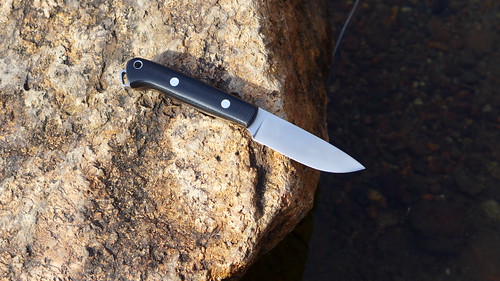
Here is my video overview:
Twitter Review Summary: Cutting edge steel and timeless craftsmanship in a convenient package.
Design: 2
Built like a bank vault and looking like a paring knife, the Little Creek is an ideal EDC fixed blade.
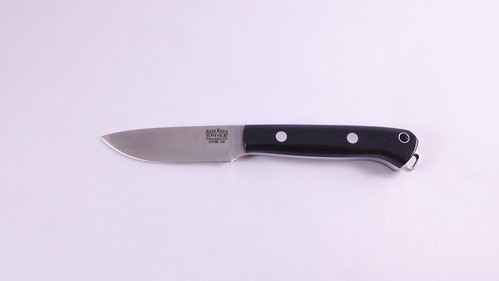
Often, designs like these get over somethinged. They are either overbuild and can't ride in a pocket (what's the point then), or they are overdesigned and lack basic functionality, or they are overly simple and run steels and grinds that can't keep up with the state of the art. Here Mike Stewart combined a solid form factor with an awesome grind and great steel. The size is just right, at 5.5 inches in overall length. The sheath is great. Amazing package.
Fit and Finish: 2
I talked about this in the Custom v. Midtech v. Production debate, but it bears mentioning here--Bark River's production methods are exceptional for a company that makes a many blades as they do. They hand grind stuff. They hand polish stuff. And everything is hand assembled. And it shows. Bark River knives, the Little Creek included, glow. They exude quality and invite your hands. Everything is more than finger flush, this is fingernail flush. Spot on with no problems at all. A gleaming example of a fixed blade. Mike any thoughts on a folder? How about a flipper?
Handle Design: 1
I loved the round, hand-filling shape of the handle. I liked the mild parrot's beak at the back end. But there was precious little to keep my hand from sliding forward. In a few tough cuts (more below) I felt my finger sliding toward the blade and had to reposition it. A more pronounced transition would help tremendously.
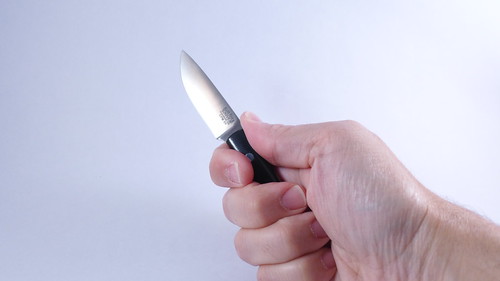
The handle is definitely not bad, but I'd like a little more blade protection. Kyle Ver Steeg's Imp solves this problem elegantly and does so on an even smaller knife:

Steel: 2
I relish writing the steel sections on reviews involving new steel. The reason is simple--I get to relive all of the cutting and chopping and slicing that knife knuts like to do. The testing here was more extensive than normal. I did the regular EDC tasks--package opening, etc--and it did great. Duh. But then I did two other things--first, I did a lot of kitchen prep--slicing apples, cutting grapes, cutting cheese, preparing two steaks (while camping), and cutting up bacon (again while camping). Then, in a stunt that I am sort of ashamed to admit, in part because I rail against folks that abuse knives simply to abuse them, I chopped down and delimbed a hickory sapling.
Hickory is a super tough wood, with a high specific density and a very tough straight grained composition. I found a small stand of these trees and wanted one to make a walking stick out of, so I decided to hack two down. One was felled by the uber-sweet Gransfor Bruks Wildlife Hatchet and the other was slowly, methodically, and tortuously felled by this little booger. When I tell you this took a long time I mean it. Using alternating chopping strokes I eventually took the 1 1/2" diameter tree down. It took easily a half an hour, almost certainly longer. But the edge was quite useable still, enough, once clean, to easily cut up a steak.
One caveat, after the cooking, I cleaned the blade with regular old dish soap, and like the Imp above, some mild rainbow discoloration occurred. I tried just about everything to get it out and it lessened it, but it is still noticeable. It has not impacted the steel or promoted rusting, but it is visible. If you only like LNIB looking blades, 3V is not for you. If you want to use the shit out of your stuff, I doubt 3V will ever let you down. It is significantly tougher and harder than 1095, 52100, 154CM, and VG-10. Those are the steels I have used in knives that did something like what the Little Creek did and the 3V was noticeably better. There was no chipping or rolling at all and even after extensive work, a bit of stropping brought the edge back to shaving sharp (which is how the knife came, BTW).
Blade Shape: 2
Geez, it seems these simple blade shapes just work the best. I don't think I have ever said that before. Maybe I should say it more often. PER-FECT.
Grind: 2
This my first blade with a convex grind and it works as advertised. You can see the grind lines and a gentle curve in them here:
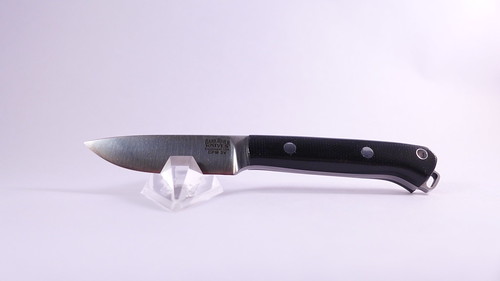
I will admit that this knife didn't slice apples so much as it split them, but then again any knife this thick will have trouble slicing regardless of the grind. In hacking tasks, it held up quite well and a quick strop brought back the edge, just as promised. I am a convert--convex grinds on fixed blades are the way to go.
Sheath Carry: 2
This is the first production fixed blade that I have had that I thought had a great and not just good sheath. Cold Steel's sheathes are good as are Spyderco's but kydex lacks the feel of leather. And this is a great sheath both on your belt and in your pocket. And no, it did not come stained--this is the cost of having a four year old around. I took the knife out of the box, then removed the sheath, and while I was doing what all knife knuts do when they get a new knife (arm hair shaving), he was both inspecting the sheath and eating peanut butter and jelly. Hence the stain.
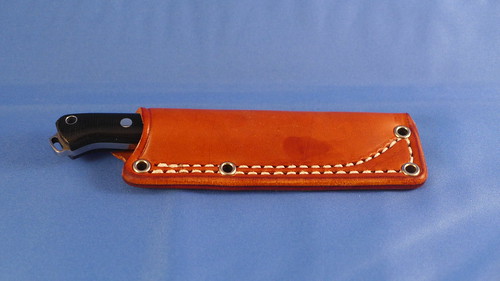
Thanks to the simple and slim profile it drops in and hides away, just about as good as you can get for an EDC fixed blade. I imagine there are better ways out there, I just haven't seen them. On the belt, this sheath is rock solid. I'd like an option for horizontal carry, as this knife is slim enough to do it, but alas that is not in the cards here. Still, damn good job and the first production sheath that didn't seem like an afterthought.
Sheath Accessibility: 2
The sheath only lets a tiny portion of the handle poke out, but it is enough. This is not some snap, push, pull jalopy. Instead it just pops right out. The fit is snug, especially when the sheath is new, but it is pretty darn good once broken in. I like it a lot, but again, I'd like to see some horizontal carry options.
Useability: 2
In the whole hickory delimbing episode proved that this is a knife that can work and do so very comfortably in the hand. I never got a hotspot and though I wished I had more of a guard for my fingers I never had a problem. The very rounded handle worked exceptionally well and affording many different angles and grips. People, including Kyle Ver Steeg (MD, hand surgeon...you know he knows something about hands, right?), rave about Bark River's handles and now I know why.
Durability: 2
3V. Huge slab. Corby bolts. Epoxy. Convex grind. Mix all that together and you have a knife that can take a beating. Other than the weird dish soap stain (and the 4 year old kid's thumb print on the sheath), there is no real evidence of use. It boggles the mind how awesome the steel and the grind are together. I wouldn't bitch if Bark River did all their knives in 3V. Its pretty awesome stuff and with their grinding skill...I just haven't had anything come close. This really makes me want to try a Busse. I just can't see how something could be tougher than this, but until I have had a Busse, I don't feel comfortable saying this is the end all, be all. But regardless of the missing data point, this thing is a tank. A tiny tank, but a tank nonetheless.
Overall Score: 19 out of 20
What a great introduction to 3V, to Bark River, and to convex grinds in general. I am very impressed. Until Bark River makes other knives of this size in 3V (the Bravo Necker in 3V seems to be out of production and widely unavailable) or someone else decided to compete with them (an ESEE Candiru in 3V makes me giddy just thinking about it) there is nothing that really runs with the Little Creek and the Mini Canadian performance-wise. The steel is such a huge upgrade over other steels used in fixed blades that it easily justifies the price increase over the regular A2 Little Creek. I'd love to see a PSK in 3V, as it would offer more hand protection, but a small tweak to the Little Creek's profile would do that as well. This isn't a perfect knife, but it is damn close. If you are looking for an EDC fixed blade, its probably impossible to do better right now.
It
blew
me
away.
Seriously, this little cutter with a convex edge sliced and diced with ease. It took a thumping and kept on coming. I did stuff with this knife that I pretty much NEVER do to review samples, but with the steel and the build quality I thought it could take it. And it did. And then this portly shorty laughed and asked for more. If you are looking for a good EDC fixed blade, look no further.
Here is the product page. The Little Creek 3V (there is an A2 version as well; its cheaper) starts around $130 and goes up to over $200 depending on the handle material. If your a poor boy, opt for the black Micarta. If you are Daddy Warbucks, the stag handled version is quite nice. Here is a good thread on it over at Blade Reviews. Here is a video review. Here is a link to KnivesShipFree, where you can find the Little Creek, and all proceeds benefit the site when you purchase things through this link:
KnivesShipFree
Here is my review sample (purchased with site money to be given away in the soon to be unveiled Everyday Commentary Giveaway Spectacular, coming Veteran's Day 2014):

Here is my video overview:
Twitter Review Summary: Cutting edge steel and timeless craftsmanship in a convenient package.
Design: 2
Built like a bank vault and looking like a paring knife, the Little Creek is an ideal EDC fixed blade.

Often, designs like these get over somethinged. They are either overbuild and can't ride in a pocket (what's the point then), or they are overdesigned and lack basic functionality, or they are overly simple and run steels and grinds that can't keep up with the state of the art. Here Mike Stewart combined a solid form factor with an awesome grind and great steel. The size is just right, at 5.5 inches in overall length. The sheath is great. Amazing package.
Fit and Finish: 2
I talked about this in the Custom v. Midtech v. Production debate, but it bears mentioning here--Bark River's production methods are exceptional for a company that makes a many blades as they do. They hand grind stuff. They hand polish stuff. And everything is hand assembled. And it shows. Bark River knives, the Little Creek included, glow. They exude quality and invite your hands. Everything is more than finger flush, this is fingernail flush. Spot on with no problems at all. A gleaming example of a fixed blade. Mike any thoughts on a folder? How about a flipper?
Handle Design: 1
I loved the round, hand-filling shape of the handle. I liked the mild parrot's beak at the back end. But there was precious little to keep my hand from sliding forward. In a few tough cuts (more below) I felt my finger sliding toward the blade and had to reposition it. A more pronounced transition would help tremendously.

The handle is definitely not bad, but I'd like a little more blade protection. Kyle Ver Steeg's Imp solves this problem elegantly and does so on an even smaller knife:

Steel: 2
I relish writing the steel sections on reviews involving new steel. The reason is simple--I get to relive all of the cutting and chopping and slicing that knife knuts like to do. The testing here was more extensive than normal. I did the regular EDC tasks--package opening, etc--and it did great. Duh. But then I did two other things--first, I did a lot of kitchen prep--slicing apples, cutting grapes, cutting cheese, preparing two steaks (while camping), and cutting up bacon (again while camping). Then, in a stunt that I am sort of ashamed to admit, in part because I rail against folks that abuse knives simply to abuse them, I chopped down and delimbed a hickory sapling.
Hickory is a super tough wood, with a high specific density and a very tough straight grained composition. I found a small stand of these trees and wanted one to make a walking stick out of, so I decided to hack two down. One was felled by the uber-sweet Gransfor Bruks Wildlife Hatchet and the other was slowly, methodically, and tortuously felled by this little booger. When I tell you this took a long time I mean it. Using alternating chopping strokes I eventually took the 1 1/2" diameter tree down. It took easily a half an hour, almost certainly longer. But the edge was quite useable still, enough, once clean, to easily cut up a steak.
One caveat, after the cooking, I cleaned the blade with regular old dish soap, and like the Imp above, some mild rainbow discoloration occurred. I tried just about everything to get it out and it lessened it, but it is still noticeable. It has not impacted the steel or promoted rusting, but it is visible. If you only like LNIB looking blades, 3V is not for you. If you want to use the shit out of your stuff, I doubt 3V will ever let you down. It is significantly tougher and harder than 1095, 52100, 154CM, and VG-10. Those are the steels I have used in knives that did something like what the Little Creek did and the 3V was noticeably better. There was no chipping or rolling at all and even after extensive work, a bit of stropping brought the edge back to shaving sharp (which is how the knife came, BTW).
Blade Shape: 2
Geez, it seems these simple blade shapes just work the best. I don't think I have ever said that before. Maybe I should say it more often. PER-FECT.
Grind: 2
This my first blade with a convex grind and it works as advertised. You can see the grind lines and a gentle curve in them here:

I will admit that this knife didn't slice apples so much as it split them, but then again any knife this thick will have trouble slicing regardless of the grind. In hacking tasks, it held up quite well and a quick strop brought back the edge, just as promised. I am a convert--convex grinds on fixed blades are the way to go.
Sheath Carry: 2
This is the first production fixed blade that I have had that I thought had a great and not just good sheath. Cold Steel's sheathes are good as are Spyderco's but kydex lacks the feel of leather. And this is a great sheath both on your belt and in your pocket. And no, it did not come stained--this is the cost of having a four year old around. I took the knife out of the box, then removed the sheath, and while I was doing what all knife knuts do when they get a new knife (arm hair shaving), he was both inspecting the sheath and eating peanut butter and jelly. Hence the stain.

Thanks to the simple and slim profile it drops in and hides away, just about as good as you can get for an EDC fixed blade. I imagine there are better ways out there, I just haven't seen them. On the belt, this sheath is rock solid. I'd like an option for horizontal carry, as this knife is slim enough to do it, but alas that is not in the cards here. Still, damn good job and the first production sheath that didn't seem like an afterthought.
Sheath Accessibility: 2
The sheath only lets a tiny portion of the handle poke out, but it is enough. This is not some snap, push, pull jalopy. Instead it just pops right out. The fit is snug, especially when the sheath is new, but it is pretty darn good once broken in. I like it a lot, but again, I'd like to see some horizontal carry options.
Useability: 2
In the whole hickory delimbing episode proved that this is a knife that can work and do so very comfortably in the hand. I never got a hotspot and though I wished I had more of a guard for my fingers I never had a problem. The very rounded handle worked exceptionally well and affording many different angles and grips. People, including Kyle Ver Steeg (MD, hand surgeon...you know he knows something about hands, right?), rave about Bark River's handles and now I know why.
Durability: 2
3V. Huge slab. Corby bolts. Epoxy. Convex grind. Mix all that together and you have a knife that can take a beating. Other than the weird dish soap stain (and the 4 year old kid's thumb print on the sheath), there is no real evidence of use. It boggles the mind how awesome the steel and the grind are together. I wouldn't bitch if Bark River did all their knives in 3V. Its pretty awesome stuff and with their grinding skill...I just haven't had anything come close. This really makes me want to try a Busse. I just can't see how something could be tougher than this, but until I have had a Busse, I don't feel comfortable saying this is the end all, be all. But regardless of the missing data point, this thing is a tank. A tiny tank, but a tank nonetheless.
Overall Score: 19 out of 20
What a great introduction to 3V, to Bark River, and to convex grinds in general. I am very impressed. Until Bark River makes other knives of this size in 3V (the Bravo Necker in 3V seems to be out of production and widely unavailable) or someone else decided to compete with them (an ESEE Candiru in 3V makes me giddy just thinking about it) there is nothing that really runs with the Little Creek and the Mini Canadian performance-wise. The steel is such a huge upgrade over other steels used in fixed blades that it easily justifies the price increase over the regular A2 Little Creek. I'd love to see a PSK in 3V, as it would offer more hand protection, but a small tweak to the Little Creek's profile would do that as well. This isn't a perfect knife, but it is damn close. If you are looking for an EDC fixed blade, its probably impossible to do better right now.
